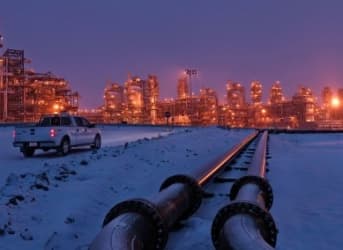Canada’s oil production could see a small increase this year as several major projects that were planned before the collapse in oil prices reach their completion. But the project pipeline, so to speak, looks pretty empty beyond the current crop of projects under construction.

Canada produced 4.5 million barrels of oil per day (mb/d) in 2015, which could rise slightly to 4.6 mb/d this year and 4.8 mb/d in 2017 as a few major projects finish up. Related: The Great Glut: Why LNG Markets Might Not Balance Before 2025
However, according to the comments from several executives at the top oil sands companies – Suncor Energy, Cenovus Energy and Meg Energy – the megaprojects of yesteryear are likely a thing of the past. Speaking at the CAPP Scotiabank Investment Symposium in Toronto this week, the industry signaled its intent to scale down its ambitions. “The years of large, multibillion-dollar projects are probably gone,” Alister Cowan, CFO of Suncor, said on April 12. After the CAD$13 billion (USD$10 billion) Fort Hills project, which Suncor is developing along with Teck Resources, Suncor will probably pursue “smaller, more modular-type projects.”
The focus will shift on ways to cut costs, rather than on developing major new sources of production. For example, Suncor is looking at using radio waves to replace steam, and Cenovus and Meg are exploring the use of solvents to cut down on their use of steam in order to reduce expenses.
But Canada’s oil industry has been hit hard by the downturn, and no amount of tinkering can make up for the enormous plunge in revenues from low oil prices. Collectively, Canada’s oil and gas producers will be cash flow negative this year, with spending plans of around $30 billion, but revenues of just $17 billion. Related: Mexico’s Clean Energy Market Is Surging
That likely means that companies will not only decline to undertake major new projects, but they also will likely stay away from them for quite a while even when oil prices rebound. “There are balance sheets to be repaired, equipment to be fixed at $60 per barrel,” Peter Tertzakian, chief energy economist and managing director at ARC Financial Corp., told The Financial Post. “The board of directors and CEOs of companies aren’t going to immediately sanction new projects. The era of big oil projects is likely delayed at a minimum for several years.”
The market is so depressed that when companies go to try and sell their assets to raise cash, they are having trouble finding willing buyers. “Since mid-2014 as oil prices came down, it has been difficult to align buyers and sellers,” said David Baboneau, managing director at Scotia Waterous, according to The Financial Post. “It becomes increasingly difficult to get an agreement on asset pricing, when prices are dropping essentially day-to-day.” Some Canadian companies are so concerned about not being able to find buyers for their assets that they are conducting negotiations privately so that the markets aren’t privy to potential failed deals. Related: Oil Slips While All Eyes Are On Doha
“The fundamentals are so wrecked for so many companies that they are losing opportunities,” said Ian Dundas, CEO of Enerplus Corp., a Calgary-based oil and gas producer. He also said that Enerplus’ divestitures are sorely needed to shore up the damaged finances. “Balance sheet trumps growth, we are not drilling through inventory. It’s the most difficult M&A market I can remember. It has been a hard market to deal with.”
The Canadian Association of Petroleum Producers (CAPP) released new figures on April 7, showing that Canada could see a decline in oil and gas spending by $50 billion in 2016 from 2014 levels, down from $81 billion to $31 billion. That would mark a 62 percent decline, the worst two-year showing for the industry since it started tracking data back in 1947. Also, the number of wells drilled will fall from 10,400 in 2014 to just 3,500 this year, a 66 percent decline.
The trade association said that more pipeline capacity was one of the most important objectives for the industry. “The United States, our only customer and No. 1 competitor, is certainly not standing still,” CAPP President Tim McMillan said. However, Keystone XL is dead, and several alternative routes are also facing an uphill battle. There are very few, if any, bright spots on the horizon for Canada’s oil producers.
By Nick Cunningham of Oilprice.com
More Top Reads From Oilprice.com:
- Are We On The Right Track To An Oil Price Recovery?
- OPEC Report Suggests Massive Oil Price Rebound
- Why India Matters More For Oil Than China


















